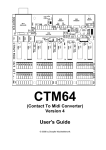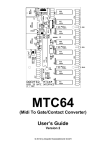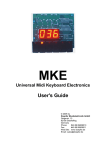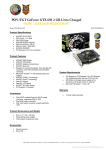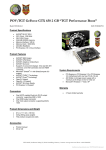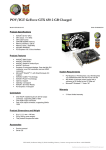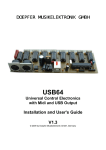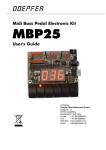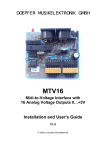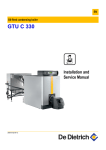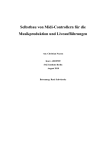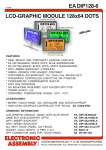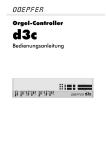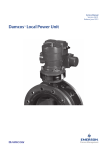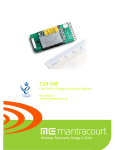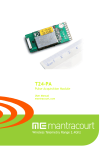Download OEM PRODUCTS 2015-01
Transcript
DOEPFER OEM PRODUCTS 2015-01 This catalogue shows all our OEM products that are available at present. OEM is the abbreviaton of original equipment manufacturer. An OEM product is not a ready-made device but a DIY (do it yourself) kit that has to be completed by the customer to obtain a working unit. An OEM product cannot be used independently but has to be combined with additional electrical or electronical equipment to become a working device (e.g. rotary or fader potentiometers, rotary encoders, buttons, LEDs, keyboard, pitch bend or modulation wheel, power supply, case/housing and so on). Electronic basic knowledge is required to operate and install an OEM product. For example several controlling elements - like potentiometers, buttons, LEDs and similar - have to be added by the customer and the complete construction has to be assembled into a suitable case. For OEM products that have to be connected to mains voltage (e.g. the MTC power board) installation and wiring has to be carried out by qualified personnel only because of electrical safety (dangerous mains voltage 115V / 230V). Not qualified personell is not allowed to install and run such devices! DANGER TO LIFE ! In any case the user has to read the installation manual carefully and follow all instructions in the manual meticulously ! When you are not sure if your knowledge is sufficient please refrain from ordering and operating an OEM product. You may consult an expert in your circle of friends who can help you. We cannot take back modules that have become defective because of wrong installation or wrong connection of the keyboards or controlling elements. We also cannot take back modules or cables which have been soldered by the user. The manufacturer of an OEM product does not know the final assembly of the complete device in which the OEM product is used as a part of the complete device. The final responsibility with regard to electrical safety and electromagnetic compatibility is up to the user who is assembling the complete device. On all our OEM products preventing measures against electromagnetic radiation are met (e.g. RF filters at the power supply input and the MIDI lines). But it is impossible to estimate to what extend the components added by the user affect the EMC properties of the complete assembly. Therefore the complete device has to be shielded against electromagnetic radiation (incoming and outgoing). These demands are normally met by a closed metal case that covers the complete assembly. The metal case should be connected to GND of the device in question. Our OEM/DIY products can be used to built your own unique midi controller (keyboard 2/3/4/5 octaves + rotary potentiometers + faders + switches + rotary encoders) or midi controlled switches (lamps, relays, magnets, motors, LEDs ....). www.doepfer.com DOEPFER DIY SYNTHESIZER OEM PRODUCTS PRODUCTS OEM Analog Synthesizer Kit pc board The DIY synth is the beginning of a a new product line: a low cost DIY kit to build a full-fledged analog synthesizer. The kit is made of an assembled and tested pc board that includes all that is necessary to build a standard analog synthesizer: VCO: Sawtooth and Rectangle output, rectangle with variable pulse width, four frequency CV inputs (1V/octave with tempco option) plus summing input, two PW/PWM CV inputs plus summing input, linear FM input, hard sync input VCF: 12 dB multimode filter, low, high and bandpass outputs (optional low-notch-highpass with external potentiometer), two frequency CV inputs plus summing input, audio input plus summing input, overdrive/distortion possible, manual resonance control (up to self oscillation) VCA: exponential control scale, one CV input plus summing input, two audio inputs plus summing input, overdrive/distortion possible, audio output ADSR: connections for attack, decay, sustain and release controls, connection for range switch (3 ranges) and LED, gate input, ADSR output LFO: connections for frequency control, range switch (3 ranges) and LED, triangle and rectangle outputs Slew Limiter: connection for slew control, input, output Inverter: input plus summing input (can be used e.g. to built a mixer), output Remark: The summing inputs (VCO frequency CV sum, VCO PW CV sum, VCF frequency CV sum, VCF audio sum, VCA CV sum, VCA audio sum) can be used to increase the number of CV or audio inputs if the available number of inputs is not sufficient. The additional inputs have to be connected to the sum input in question via serial resistors. The value of the resistor in question defines the sensitivity of the corresponding CV or audio input. Additionally required resistors are not included with the kit ! The kit is planned for customers who are familiar with electronic basics as the kit does not include the controls, switches, sockets, power supply and the case. These elements have to be added and wired by the customer. The board is equipped with dual row pin headers. This enables the usage of dual row female connectors instead of soldering the controls directly to the pins. The customer can choose the desired size, shape, type and color of these elements (e.g. rotary potentiometers or faders, small 3.5 mm jack sockets or ¼" sockets or banana type, small or large knobs and switches and so on). Even the type of Application Example wiring is free: the range goes from a pre-wired standard synth (VCO-VCF-VCA type) up to a fully patchable modular system. Two or more of the kits can be combined to obtain more VCOs, ADSRs, LFOs, VCAs or VCFs, e.g. to built a more complex pre-wired or modular synth. We also think about a DIY expansion board that may contain a noise generator, S&H, ring modulator, mixer, maybe Midi/USB interface and multi-effect unit, and other often used synthesizer units. A stabilized symmetrical 12V power supply (i.e. -12V, GND, +12V, A-100 compatible) with at least 150 mA current is required. The additional working time and required skills to build a working unit from the kit should not be underrated ! To obtain all features about 25 potentiometers, 20 sockets and several switches have to be mounted into a suitable housing and wired faultless. We ask for your understanding that we cannot offer the service to troubleshoot a customer’s assembly. The pc boards comes assembled and tested. Only the adjustment of the 1V/octave scale and the frequency offset of the VCO have to be carried out by the customer. We do not offer complete units but only the assembled and tested pc board ! The pictures show application examples for the DIY synth board. Assemblies like these are not available from us ! We also do not offer kits with unassembled pc boards (i.e. kits that include the electronic parts and the unassembled pc board and the customer has to assemble and solder the parts) as we made some bad experiences in the past with such kits. Some customer application examples are available on our website: DOEPFER MUSIKELEKTRONIK GMBH Geigerstr. 13 D-82166 Graefelfing / Germany Phone 089-89 80 95 10 Fax 089-89 80 95 11 www.doepfer.com [email protected] DOEPFER USB64 OEM PRODUCTS PRODUCTS OEM Universal MIDI Control Electronics with 64 inputs, Midi and USB interface USB64 is a universal electronics for DIY of Midi control boxes with USB and/or Midi interface. Up to 64 elements can be connected to USB64. q Headwords: q 64 inputs, alternatively analog (0...+5V, e.g. generated by rotary or fader potentiometers, same as Pocket Electronic) or digital (e.g. generated by momentary or toggle switches/buttons, same as CTM64) q in analog mode Midi control change messages are generated, resolution 7 bit (Midi data range 0-127) q in digital mode note on/off or program change messages are generated q inputs via eight pin headers with 10 pins each (same pinout as Pocket Electronic), 10 pin ribbon cables with suitable female connectors are plugged to the pin headers, the ribbon cables are included with the USB64 (about 30 cm each), the other side of each cable is open to connect the desired controls q USB and Midi Out (no Midi In) q power supply alternatively via USB or external power supply (e.g. for Midi operation without USB), selectable via jumper q basic parameters (e.g. analog/digital mode, q q q q q Midi channel, Midi note/program change/control change range 0-63 or 64-127 etc.) are selected via jumpers update of the USB64 firmware via USB (e.g. in case of a firmware update, for this a PC with Windows XP and USB interface is required), as soon as an update is available it can be downloaded from our download page control LED measures of the pc board: about 160 length x 55 width x 25 height (measures in mm) scope of supply: * USB64 pc board (completely assembled and testet) * eight 10 pin ribbon cables with female headers (about 30 cm each) * USB cable (A-B type), * only within Europe: power supply (230V version with European mains connector if you order from outside Europe please ask your local dealer if a power supply is included For detailed information the user's manual is available as pdf file. Remark: USB64 is not suitable for rotary encoders (sometimes even called endless potentiometers). For this appliction the Dial Electronic has to be used as these controls are no real potentiometers. DOEPFER MUSIKELEKTRONIK GMBH Geigerstr. 13 D-82166 Graefelfing / Germany Phone 089-89 80 95 10 Fax 089-89 80 95 11 www.doepfer.com [email protected] DOEPFER OEM PRODUCTS PRODUCTS OEM CTM64 Contact-To-MIDI Universal MIDI Out Kit pc board dimensions: 90 x 105 mm CTM64 is an universal MIDI Out kit. Up to 64 free contacts can be connected to generate MIDI note on/off or program change messages. CTM is suitable to retrofit keyboards, switch panels, button arrangements or any other contacts so that they are able to transmit MIDI data. Up to 4 potentiometers can be connected to generate common MIDI controllers and pitch bend. Additionally a 1/4 jack socket is available for connecting a sustain pedal. Two different modes are selected with the first of 8 jumpers: note on/off or program change. In the note mode closing of a contact generates the corresponding MIDI note on message, opening generates note off - both without velocity (velocity is fixed to 100). In the program change mode closing of a contact leads to the corresponding MIDI program change message. The note offset (i.e. the MIDI note number assigned to the first contact) can be set to 0 or 36 with the second jumper. With two more jumpers one can transpose up/down one octave, i.e. +12/-12 semitones. Instead of these jumpers a 3-position switch (1-0-1) working as an octave switch can be soldered to the corresponding pins of the jumper pin header. In this way the note offsets 0, 12, 24, 36 and 48 are available. If another note offset (e.g. 41) is required the contacts are displaced correspondingly and the unused contact terminals are left free. In the program change mode the offset can be set to 1 or 64, i.e. setting the program number range to 1-64 or 65-128 (0-63 or 64-127 in MIDI code). With two daisy-chained CTM64 the whole range 1...128 is covered. The 4 potentiometer plugs are used to connect up to 4 potentiometers (e.g. rotary, slider, wheels) generating the MIDI messages pitch-bend, modulation (controller #1), volume (controller #7) and monophonic after touch. The 1/4“ jack socket can be used to insert a sustain pedal (contact type ”closed at rest” is required) generating the MIDI sustain message (controller #64). The MIDI channel for all messages transmitted by the CTM64 is set with the last 4 jumpers. The 64 contacts are connected to four double row pin headers with 16 pins each. 16 pin socket-connectors with flat cable can be connected to these pin headers (not included with the CTM64). Additionally there is one common pin for all contacts. Pay attention that only free contacts can be used. This means that the contacts are not allowed to be connected with another electronics or connected with a fixed voltage (e.g. GND). For the potentiometer four male pcb connectors with 3 pins (GND, slider, +5V) are available. Suitable female connectors with assembled cables can be connected to these pin headers (not included with the CTM64). CTM64 is equipped with MIDI In and MIDI Out. The incoming MIDI messages are merged to the data generated by the CTM64. In this way several CTM64 can be linked together (e.g. 3 CTM64 required for 2 keyboards with 61 keys and one basepedal with 32 keys, or switch boards with more than 64 switches). CTM64 is available only as an assembled and tested pc board. The pc board measures are about 90 x 105 mm. Four mounting holes with 3 mm diameter are available for mounting the pc board to a suitable base e.g. with distance sleeves or spacers and screws (black dots in the above picture). The configuration of CTM64 (i.e. MIDI channel, mode, note offset and so on) is made by the customer with 8 jumpers - as described above. We do not offer a suitable housing as the CTM64 is normally installed into the housing of the keyboard or switch board. An external power supply (7-12VDC@min. 250mA) is required. It is not included with the CTM64. You will find a suitable power supply in our price list. A connector set suitable for CTM64 is available at extra charges. This set includes four 16 pin flat cables with 16 pin socket connectors pressed to the cables at one end (length about 50cm) and four 3 pin female connectors with assembled cables for the potentiometers (length about 30cm, potentiometers are not included). The counterpart to CTM64 is the MTC64 (= MIDI to Contact) that converts 64 succeeding note or program change messages into 64 0/+5V TTL signals. With suitable drivers relays, lamps or electromagnetic valves can be controlled via MIDI. DOEPFER MUSIKELEKTRONIK GMBH Geigerstr. 13 D-82166 Graefelfing / Germany Phone 089-89 80 95 10 Fax 089-89 80 95 11 www.doepfer.com [email protected] DOEPFER OEM PRODUCTS PRODUCTS OEM CTM RELAY BOARD power supply output (to other relay boards) connectors to CTM64 main board (common line) power supply input LED controls relays relay control inputs (connected to simple on/off contacts) The CTM Relay Board is an expansion board for the universal MIDI control electronics CTMC64. The reason for this this additional board is the limited cable length between CTM64 main board and the contacts (max. about 50 cm / 2 ft). By means of the relay board the cable length can be extended to 100 m (~ 300 ft) and even more. The working principle is very simple: The relay board is equipped with 16 reed relays that can be switched via very long cables. The relay board is placed near the CTM64 main board and the contacts inside the relays are the new contacts for the CTM64 main board. Thus the cable length between the contacts and the CTM64 main board is less than 50cm but the cables used to switch the relay can be very much longer. For each relay a screw terminal is available to connect a simple 2 pin cable with the controlling contact on the other side (e.g. a momentary or toggle switch). The relay board is operated with a separate power supply to obtain a complete galvanic separation between the relays and the CTM64 main board. These are the most important features: l 16 Reed relays, the contacts of the relays are used as the contacts for the CTM64 main board l l l l l l l l relay connections via 2 pin screw terminals up to four CTM relay boards can be connected to one CTM64 main board separate power supply for the relay board(s), independent from the power supply of the CTM64 main board. An external power supply with 7-12V DC output is required. The required current depends upon the number of relays that have to be switched actually. Each relay consumes about 10mA. The full installation (i.e. 4 relay boards, all relays in operation) requires a power supply with about 640 mA additional screw terminal to operate several relay boards with one power supply only connection between each CTM relay board and the CTM64 main board via 16 pin ribbon cable, and one single cable (common line) that leads from the CTM64 main board to all relay boards the 16 pin ribbon cable is included with the relay board the power supply has to be ordered in addition (only one required, even if more than one relay board is used), see accessories and price list dimensions: 164 x 42 x 18 mm DOEPFER MUSIKELEKTRONIK GMBH Geigerstr. 13 D-82166 Graefelfing / Germany Phone 089-89 80 95 10 Fax 089-89 80 95 11 www.doepfer.com [email protected] DOEPFER OEM PRODUCTS PRODUCTS OEM MTC64 MIDI-To-Contact/ Gate-Interface pc board dimensions: 70 x 102 mm MTC64 is an universal MIDI interface that converts up to 64 succeeding MIDI note on/off or program change messages into 64 TTL voltages (0/+5V). The TTL outputs of the MTC64 can be used to control different switching functions. With suitable drivers (e.g. switching transistors) relays, lamps, motors, electromagnets, magnetic valves and so on can be controlled. A suitable 16-fold output driver board with max. 40V/500mA is available for the MTC64. For small loads (less than 5mA @ 5V, e.g.LEDs or highimpedance reed relays) the additional drivers may not be necessary. MTC64 has two different modes: note or program change mode. In the note mode incoming MIDI note on/off messages control the 64 TTL outputs provided that the MIDI channel and note range correspond to the settings of the MTC64. A note on message will set the corresponding TTL output to a high level (+5V), the note off message will reset the output to a low level (0V). With an additional jumper this bevaviour can be set to the other way round (note on = low, note off = high) if reversed outputs are required. In the program change only one of the 64 outputs is activated. The number of the activated output is identical to the program change number received at the MIDI input. The note offset (i.e. the MIDI note number assigned to the first output) can be set to 0 or 36 with another jumper. With two more jumpers one can transpose up/down one octave, i.e. +12/-12 semitones. Thus the note offsets 0, 12, 24, 36 and 48 are obtainable. If another note offset is required the unused outputs remain unconnected. In the program change mode the offset can be set to 1 or 64, i.e. setting the program number range to 1-64 or 65-128 (0-63 or 64-127 in MIDI code). With two daisy-chained MTC64 the whole program number range 1-128 is covered. Alternatively a range switch can be used instead of the range jumper. Universal kit for MIDI controlled switching applications The MIDI channel for all messages processed by the MTC64 is set with the last 4 jumpers. The 64 TTL outputs are available as four double row pin headers with 16 pins each. 16 pin socketconnectors with flat cable can be connected to these pin headers (not included with the MTC64). Additionally there are some GND pins available (as solder pins and as additional pin header with 10 pins) as a GND reference level is required for the devices controlled by the MTC64 outputs. MTC64 is equipped with MIDI In and Thru. The incoming MIDI messages are passed to MIDI Thru. In this way several MTC64 can be linked together. MTC64 is available as an assembled and tested pc board only. We do not offer a suitable housing as the MTC64 is normally installed into the housing of the device to be controlled by MTC64. An external power supply (7-12VDC@min. 250mA) is required. It is not included with the MTC64. You will find a suitable power supply in our price list. A connector set suitable for MTC64 is available at extra charges.This includes four 16 pin flat cables with 16 pin socket connectors at one end and one 10 pin flat cable with 10 pin socket connector at one end. The length for all cables is about 50cm. A suitable 16-fold output driver board with max. 40V/500mA is available at extra charges. Each output board is connected to the main board simply with a flat cable (included with the driver board). The driver outputs are available as 16 single pin holders. The power supply for the loads driven by the driver board is not included and has to be added by the customer (depends upon the voltage and current of the loads). The MTC64 is the counterpart to CTM64 (Contactto-MIDI Interface) that generates up to 64 MIDI note on/off or program change messages with free contacts connected to CTM64 (for details please refer to the CTM64 product information). DOEPFER MUSIKELEKTRONIK GMBH Geigerstr. 13 D-82166 Graefelfing / Germany Phone 089-89 80 95 10 Fax 089-89 80 95 11 www.doepfer.com [email protected] DOEPFER OEM PRODUCTS PRODUCTS OEM MTC RELAY BOARD connectors to MTC64 main board relays LED controls relay outputs The MTC Relay Board is an expansion board for the universal MIDI control electronics MTC64. It has 16 relays available that can be used as switches for many applications (e.g. audio signals, control signals, low voltage lamps/motors/magnets and many more). Another application is to connect the relay outputs in parallel to the key contacts of a synthesizer, organ or any electronic instrument that cannot be interfaced to Midi with another method. These are the most important features: l 16 potential-free relay contacts (Reed relays) l maximum current for each relay contact: 1A l maximum voltage for each relay contact: 50V l maximum power for each relay contact: 15W (15VA) (it is not allowed to go beyond any of these values, e.g. for 1A current the maximum voltage is 15V, otherwise the maximum power of 15VA would be exceeded) l l l l l l l l residual resistance of closed contact: 150mOhm relay connections via screw terminals LED control for each output up to four MTC relay boards can be connected to one MTC64 main board connection between MTC relay boards and MTC64 main board via one 10 pin ribbon cable leading from the main board to all relay boards, and a 16 pin ribbon cable between main board and relay board (one for each relay board). Please specify how many relay boards have to be connected to the main board (because of the lenght and number of female connectors of the 10 pin ribbon cable) ribbon cables are included with the relay board, cables for relay connections are not included dimensions: 163 x 52 x 18 mm For more detailed information the user's guide is available for download on our web site DOEPFER MUSIKELEKTRONIK GMBH Geigerstr. 13 D-82166 Graefelfing / Germany Phone 089-89 80 95 10 Fax 089-89 80 95 11 www.doepfer.com [email protected] DOEPFER POCKET ELECTRONIC OEM PRODUCTS PRODUCTS OEM Universal MIDI control electronics Pocket Electronics (abbreviation: "PE" in the following) is an universal electronics DIY kit to built your own MIDI control box. Up to 16 controlling elements can be connected to PE transmitting 16 different MIDI messages on different (or even the same) MIDI channels. Essentially it contains the electronics core of Pocket Control but without the 16 controls (i.e. without potentiometers). Instead of this PE is used to connect up to 16 controlling elements (e.g. rotary potentiometers, fader/slider potentiometer, touch switches, toggle switches, foot switches, foot controllers). The controlling elements are not included but have to be added by the customer. Even voltages sources can be used instead of the controlling elements provided that the voltages applied are strictly within the range 0...+5V (referenced to PE GND)! Voltages beyond this range will destroy the electronics ! The 16 controlling elements resp. control voltages are connected to two double row pinheaders (10 pins each). To these headers two 10 pin ribbon cables are connected. The controlling elements are connected to the free ends of the ribbon cables. In this way the controlling elements can be pulled off from the electronics very easily. Additionally a 4 pin connector is available to connect a button and LED (snapshot function of Pocket Control). Functionally PE is identical to Pocket Control, i.e. the most common Midi messages can be generated (any controller, after touch, pitch bend, common RPN resp. NRPN controller, but no SysEx messages). PE has 128 presets available for the assignement of MIDI events to the 16 controlling elements. The editor program (PC version) can be downloaded for free from our web site www.doepfer.de and enables the user to program his own 128 presets. The presets are selected with DIP switch or incoming MIDI program change messages. For more details please refer to the Pocket Control information ). PE is equipped with MIDI In and MIDI Out. The incoming MIDI messages are merged to the data generated by PE. In this way several PE can be linked together to obtain larger controller arrays with more than 16 elements. Even the combination of PE and CTM64 is possible to add controller events to the note or program change events generated by CTM64. PE is available only as an assembled and tested pc board. The pc board measures are about 80 mm (length) x 56 mm (width) x 25 mm (height). Five mounting holes with 3 mm diameter are available for mounting the pc board to a suitable base e.g. with distance sleeves or spacers and screws. PE includes two 10 pin ribbon cables (about 30 cm each), button and LED (snapshot function) and the power supply.Ê We do not offer a suitable housing as this would have to be completely different for various combinations of controlling elements. An external power supply (7-12VDC@min. 100mA) is required for the PE. It is included with the PE (230V version with European mains plug). Electronic basic knowledge is required to install the PE electronics and to connect the controlling elements resp. control voltages. If you are not sure if your knowledge is sufficient please consult an expert. We cannot take back modules that became defective because of wrong installation or wrong connection of the controlling elements or voltages. We also cannot take back modules or cables which have been soldered by the user. DOEPFER MUSIKELEKTRONIK GMBH Geigerstr. 13 D-82166 Graefelfing / Germany Phone 089-89 80 95 10 Fax 089-89 80 95 11 www.doepfer.com [email protected] DOEPFER WHEEL ELECTRONIC OEM PRODUCTS PRODUCTS OEM Universal Midi electronics for wheels, foot controllers joy-sticks, breath-controllers Wheel Electronic (abbreviation: "WE" in the following) is a universal electronics DIY Midi kit designed to connect modulation or pitch wheels. But it can be used also for joy sticks, single or multiple foot controllers (analog or on/off), breath controllers or even normal potentiometers. In addition a connector for a sustain foot switch is available. Up to 4 continuously variable "analog" elements and a "digital" switching element (e.g. a sustain foot switch) can be connected. Application examples: q wheels q pitch bender q joy sticks q breath controllers q foot controllers (continuos) q foot switches (on/off), momentary or toggle q rotary potentiometers q slider/fader potentiometers of rotation. Even breath controllers (e.g. Yamaha BC-1/2/3) output only about +3.5V maximal control voltage. For each of the four elements a jumper is used to select if the full voltage range (0...+5V) or the adjustable voltage range is used for measurement. This is necessary if different elements are used simultaneously (e.g. modulation wheel and slider potentiometers). If an element is assigned to Midi pitch bend a "plateau" is used in the middle of the voltage/data range (data value 64). This feature is meaningful in combination with springloaded wheels or joy sticks as due to mechanical tolerances the exact center position is not always reached. Four jumpers are used to select the Midi channel. Further four jumpers are used to select up to 16 different Different elements can be combined simultaneously. Here combinations of Midi control change numbers, pitch bend or are some examples: after touch - the so-called presets. A detailed list of all q pitch bender, modulation wheel, volume control (rotary or available combinations can be found in the user's manual slider potentiometer), breath controller and sustain foot The elements connected to WE (e.g. wheels, joy sticks, foot switch controllers, normal potentiometers, foot switch) are not included but have to be added or purchased in addition by q pitch bender, three modulation wheels (e.g. modulation, volume, after touch) and sustain foot switch the customer. The Midi data range is 0...127 with 7 bit resolution. q pitch bender, two modulation wheels (e.g. modulation and after touch), one rotary or slider potentiometer The sampling rate is about 50 samples/second. (volume) and sustain foot switch WE is equipped with MIDI In and MIDI Out. The incoming MIDI messages are merged to the data generated by WEq pitch bender, modulation wheel and joy stick provided that the incoming Midi data range is not too big. In q two joy sticks this way several WE can be linked together or combined q four foot controllers for volume control of four Midi channels with other electronics like CTM64, MKE, Pocket Electronic q dual or tripe foot controller (on/off or analog) and rotary or or Dial Electronic). slider potentiometer An LED is used to indicate the Midi activity. WE is available only as an assembled and tested pc board. q two modulation wheels or switches to control the rotary speakers of the organ software B4 (von Native The pc board measures are about 60 mm (length) x 55 mm Instruments), two rotary or slider potentiometers for (width) x 25 mm (height). Several mounting holes with 3 mm volume and expression diameter are available for mounting the pc board to a suitable base e.g. with distance sleeves or spacers and The four "analog" elements are connected to pinheaders screws. with 3 pins. For the "digital" switching element a pinheader We do not offer a suitable housing as this would have to be with 2 pins is available. Four 3-pin cable sets and one 2-pin completely different for various combinations of controlling cable set about 30cm each with suitable female connectors elements. are included. An external power supply (7-12VDC@min. 100mA) is used. WE has some special features: Within Europe the wall outlet power supply adapter for 230V The upper voltage that is assigned to the Midi data value mains voltage and European type mains plug is included 127 can be adjusted exactly with a multi-gang trimming with the WE. In other countries the power supply has to be potentiometer in the range +3...+5V. This measure is purchased by the user in his country. If there is a Doepfer necessary e.g. for modulation or pitch wheels, foot representative in your country please ask the representative controllers or joy sticks that do not cover the complete angle if the power supply is included in your country. DOEPFER MUSIKELEKTRONIK GMBH Geigerstr. 13 D-82166 Graefelfing / Germany Phone 089-89 80 95 10 Fax 089-89 80 95 11 www.doepfer.com [email protected] DOEPFER OEM PRODUCTS PRODUCTS OEM MKE Universal Midi Keyboard Electronics MKE is an Universal Midi Keyboard Electronics to built custom-made Midi controllers that include a keyboard. Combining the MKE with our controller electronics Pocket Electronic, Dial Electronic, Wheel Electronic, CTM64 or MTC64 allows the construction of an unique Midi controller that exactly meets the requirements of the user. These units can be connected to MKE: l Any keyboard manufactured by FATAR/Italy with 2, 3, 4 or 5 octaves (with velocity) l By means of a special adapter board even the dynamic basspedals PD/2A manufactured by FATAR/Italy can be connected (avialable with 13, 17 or 20 keys) l Pitch bend wheel (special spring-loaded rotary potentiometer) l Modulation wheel (special rotary potentiometer) l Rotary or fader potentiometer for loudness/volume control (Midi CC#7) l After touch sensor or socket for sustain switch or another potentiometer for any Midi controller The MKE pc board has these controls available: l 6 rectangle momentary buttons with integrated LEDs l 3-digit LED display The 6 buttons are used to control these parameters: l Midi channel 1...16 l Transpose (lowest note = 0,12,24,36,48,60) l Program change 0...127 l Controller number 0...127 resp. After touch l Up/down (increment/decrement of the current value) MKE has a non-volatile memory for the parameters Midi channel, transpose, program and controller number. After the next power on the previous values are called up. MKE is equipped with Midi In and Midi Out. The data appearing at the Midi in are merged to the data generated by the MKE. Several MKE can be daisy-chained or combined with other OEM controllers (e.g. Pocket Electronic, Dial Electronic, Wheel Electronic, CTM64) to built a custom-made Midi controller. MKE is available as an assembled and tested pc board. The pc board measures are about 68 mm (length) x 85 (width) x 35 mm (height). Please specify in your order the type of keyboard (2/3 or 4/5 octaves). This is necessary as the keyboards with 2 and 3 octaves have different connectors compared to the 4 and 5 octaves versions. Suitable cables to connect MKE and the keyboard are required. If you have no keyboard available we recommend to order the keyboard together with the MKE as in this case the components are already connected and tested together. The MKE is available as a package together with different types of keyboards (e.g. with the organ waterfall keyboard TP/8O). We do not offer a suitable housing as this would have to be completely different for various combinations of keyboards and controlling elements. An external power supply (7-12VDC@min. 250mA) is required for the PE. In Europe it is included with the MKE (230V version with European mains plug). For other countries please contact the representative in your country. We have several accessories available: suitable keyboards (2, 3, 4 or 5 octaves), cables for the connection between MKE and the keyboards, wheels, cable sets for the wheels and the volume potentiometer, wheels and sustain socket. For details please take a look at our price list (spare parts section) or ask our sales office ([email protected]). If you order the MKE without keyboard please specify the keyboard that will be used (2, 3, 4 or 5 octaves). The connectors are different for the keyboards and the electronics has to be equipped with the suitable connectors. The cables leading to the keyboards are not included and have to be ordered in addition. For more detailed information the user's guide and a guide how to connect other keyboards are available for download on our web site www.doepfer.com. DOEPFER MUSIKELEKTRONIK GMBH Geigerstr. 13 D-82166 Graefelfing / Germany Phone 089-89 80 95 10 Fax 089-89 80 95 11 www.doepfer.com [email protected] DOEPFER MBP25 OEM PRODUCTS PRODUCTS OEM Midi Basspedal Electronics application example MBP25 is an electronics that was developed to connect the non-dynamic basspedals PD/3 manufactured by Fatar/Italy (for the dynamic bass pedals PD/2A the MKE electronics can be used in combination with a suitable adapter board). Unfortunately Fatar does not offer bass pedals with 25 or more keys but only versions with 13, 17 or 20 keys. As many customers have been asking for a basspedal with 25 keys we decided to develop the MBP25 that can be used to connect one, two or three basspedals with 13 keys each (Fatar PD/3) to obtain a 13, 25 or 37 key basspedal. The above picture shows one possibility how two PD/3 pedals can be combined to obtain a 25 key pedal with case. We offer a DIY/OEM package for a 25 key basspedal. It is made of two 13 keys pedals PD/3 and the MBP25 electronics. One of the two pedals has to be shortended by one key as one of the "C" keys is redundant. Fortunately the PD/3 pedals use a plastic frame and can be shortened with passable effort. Both pedals have to be mounted on a common base plate and a suitable case (e.g. made of varnished wood - as shown above) can be added. The base plate and the case are not included and have to be added by the customer. A third pedal can be added in the same way. For this application a special connection cable with three connectors on one of the ribbon cables is required. Remark: All basspedals manufactured by Fatar that include velocity (PD/2A) are equipped with solid steel frames and cannot be shortened in such an easy way and cannot be connected to MBP25. pc board u u u u u q q q q q q q Midi channel 1...16 Transpose probably in octave intervals Program Change operating mode: note: this is the usual play mode, the keys transmit Midi note on/off message u program change: in this mode the keys are used to transmit Midi program change messages u realtime: in this mode three of the keys are used to transmit Midi start, stop and continue u Up (increment of the value shown in the display) u Down (decrement of the value shown in the display) measures of the complete button area about 76 x 22 mm 3-digit LED display (about 19 x 38 mm) for parameter display two connectors for basspedals (compatible to Fatar PD/3) Midi In, Midi Out (connected via 30 cm long cables to enable the mounting of the sockets at the desired position) The data appearing at the Midi in are merged to the data generated by the MBP25. Consequently the MBP25 can be connected to a Midi keyboard to add the basspedal data to the keyboard data. power supply socket on board, in addition a 2-pin connector is available to connect another power supply socket near the Midi sockets (2-pin cable 30 cm with suitable female connector is included) a 3-pin connector is available to connect a rotary or fader potentiometer that transmits Midi volume, even a foot controller (e.g. FP5) can be connected. the (fixed) velocity value can be set to any value between 1 and 127. q These are the most important features of the MBP25 electronic kit: q 6 black rectangle momentary buttons (about 12 x 22 An external power supply (7-12VDC@min. 100mA) is mm) with integrated LEDs (same as used in MKE) required for the PE. It is included with the PE (230V to adjust these parameters version with European mains plug). DOEPFER MUSIKELEKTRONIK GMBH Geigerstr. 13 D-82166 Graefelfing / Germany Phone 089-89 80 95 10 Fax 089-89 80 95 11 www.doepfer.com [email protected] DOEPFER ! ! ! ! ! ! ! ! ! ! ! MTV16 OEM PRODUCTS PRODUCTS OEM Midi-to-Voltage Interface with 16 Analog Voltage Outputs interface to convert midi control changes messages to analog voltages 16 analog voltage outputs 0 ... +5V, max. load ~ 10kOhm optional amplifier board for 0...+10V available upon request resolution of the voltages: 128 steps or 7 bit (based on the 7 bit midi data) the voltages are available as two pin heades with 10 pins each, each pin header has available 8 voltages and GND on two pins the voltages are controlled by 16 subsequent midi control changes messages on the same midi channel the midi channel is adjusted by means of four jumpers the control change number of the first output can be set to 0, 16, 32, 48, 64, 80, 96 or 112 by means of three jumpers connectors for power supply and midi are available as sockets on the pcb Midi activity LED display ready built and tested pc board, dimensions: about 78 x 67 x 25 mm DOEPFER MUSIKELEKTRONIK GMBH Geigerstr. 13 D-82166 Graefelfing / Germany Phone 089-89 80 95 10 Fax 089-89 80 95 11 www.doepfer.com [email protected]












